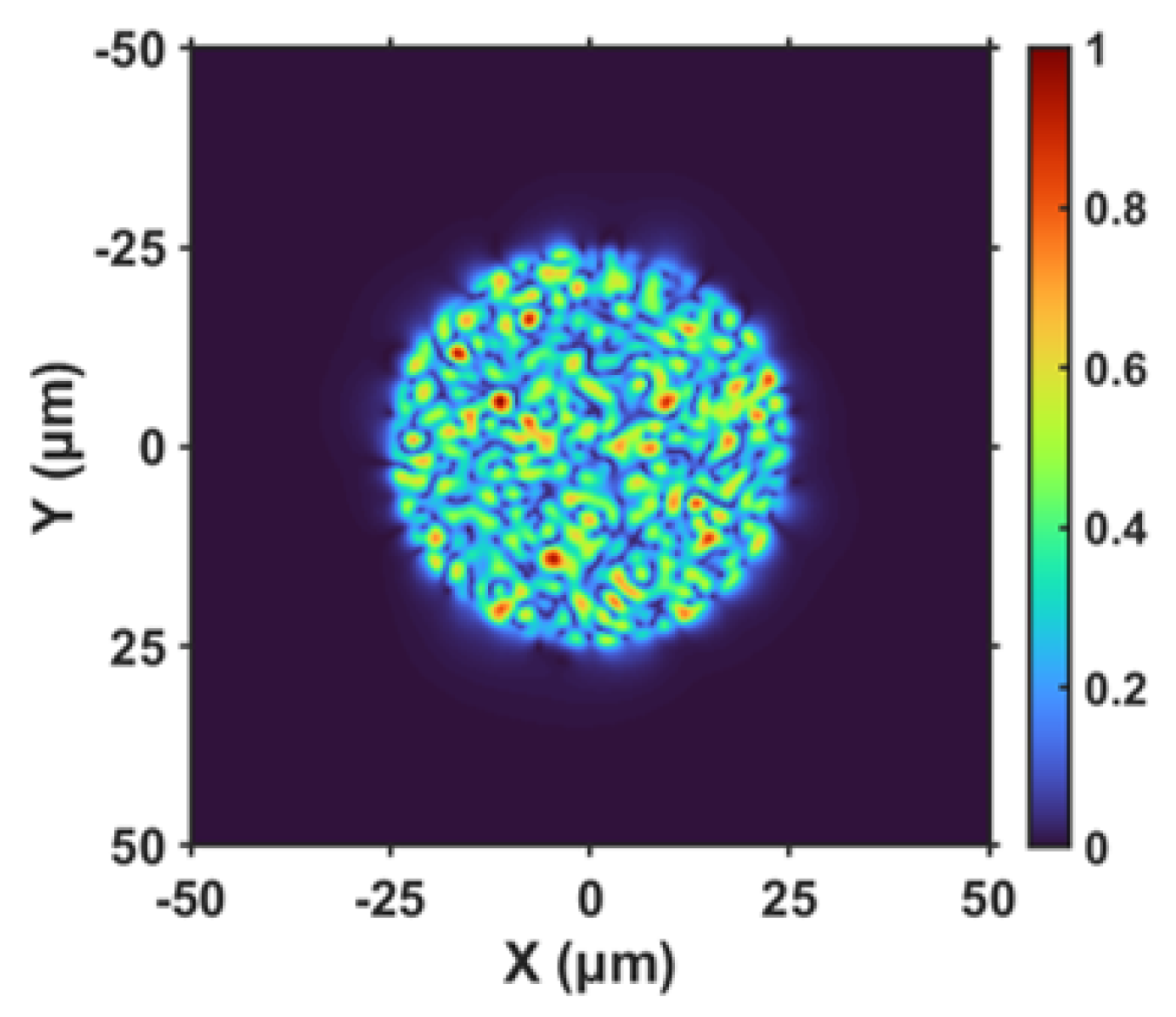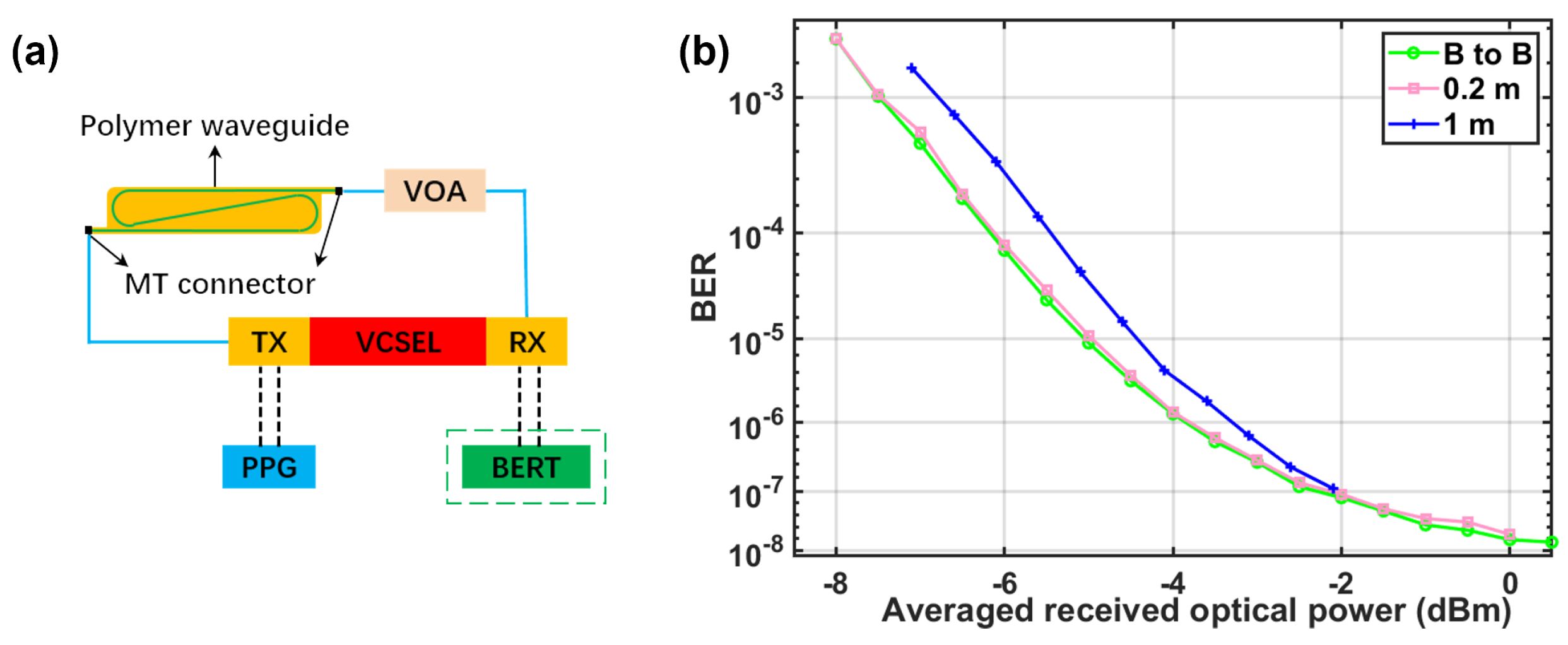Meter-Scale Long Connectorized Paper-like Polymer Waveguide Film for 100 Gbps Board-Level Optical Interconnects Application †
Abstract
1. Introduction
2. Waveguide Fabrication
3. Optical Characteristics
4. Bandwidth Study
5. Transmission Experiment
6. Conclusions
Author Contributions
Funding
Institutional Review Board Statement
Data Availability Statement
Conflicts of Interest
References
- Ghiasi, A. Large Data Centers Interconnect Bottlenecks. Opt. Express 2015, 23, 2085–2090. [Google Scholar] [CrossRef] [PubMed]
- Michelogiannakis, G.; Shen, Y.; Teh, M.Y.; Meng, X.; Aivazi, B.; Groves, T.; Shalf, J.; Glick, M.; Ghobadi, M.; Dennison, L.; et al. Bandwidth Steering in HPC Using Silicon Nanophotonics. In Proceedings of the International Conference for High Performance Computing, Networking, Storage and Analysis (SC), Denver, CO, USA, 17–19 November 2019; ACM: New York, NY, USA, 2019; pp. 1–25. [Google Scholar]
- Wu, T.; He, S.; Liu, J.; Sun, S.; Liu, K.; Han, Q.-L.; Tang, Y. A Brief Overview of ChatGPT: The History, Status Quo and Potential Future Development. IEEE-CAA J. Autom. Sin. 2023, 10, 1122–1136. [Google Scholar] [CrossRef]
- Fariborz, M.; Xiao, X.; Fotouhi, P.; Proietti, R.; Yoo, B. Silicon Photonic Flex-Lions for Reconfigurable Multi-Gpu Systems. J. Light. Technol. 2021, 39, 1212–1220. [Google Scholar] [CrossRef]
- Kang, D.; Ha, Y.; Peng, L.; Youn, C. Cooperative Distributed GPU Power Capping for Deep Learning Clusters. IEEE Trans. Ind. Electron. 2022, 69, 7244–7254. [Google Scholar] [CrossRef]
- 802.3ck; IEEE Standard for Ethernet Amendment 4: Physical Layer Specifications and Management Parameters for 100 Gb/S, 200 Gb/S, and 400 Gb/S Electrical Interfaces Based on 100 Gb/S Signaling. IEEE: Piscataway, NJ, USA, 2022. Available online: https://ieeexplore.ieee.org/servlet/opac?punumber=9999412 (accessed on 25 November 2024).
- Zhang, B.; Vasani, A.; Sinha, A.; Nilchi, A.; Tong, H.; Rao, L.P.; Khanoyan, K.; Hatamkhani, H.; Yang, X.; Meng, X.; et al. A 112-Gb/S Serial Link Transceiver with Three-Tap FFE and 18-Tap DFE Receiver for up to 43-DB Insertion Loss Channel in 7-Nm FinFET Technology. IEEE J. Solid-State Circuits 2024, 59, 8–18. [Google Scholar] [CrossRef]
- Cho, H.; Kapur, P.; Saraswat, K.C. Power Comparison between High-Speed Electrical and Optical Interconnects for Interchip Communication. J. Light. Technol. 2004, 22, 2021–2033. [Google Scholar] [CrossRef]
- Miller, B. Device Requirements for Optical Interconnects to Silicon Chips. Proc. IEEE 2009, 97, 1166–1185. [Google Scholar] [CrossRef]
- Immonen, M.; Zhang, R.; Press, M.; Tang, H.; Lei, W.; Wu, J.; Yan, H.J.; Zhu, L.X.; Serbay, M. End-To-End Optical 25Gb/S Link Demonstrator with Embedded Waveguides, 90°Out-of-Plane Connector and On-Board Optical Transceivers. In Proceedings of the 42nd European Conference on Optical Communication (ECOC), Dusseldorf, Germany, 18–22 September 2016; VDE: Berlin, Germany, 2016; pp. 1–3. [Google Scholar]
- Maniotis, P.; Terzenidis, N.; Siokis, A.; Christodoulopoulos, K.; Varvarigos, E.; Immonen, M.; Yan, H.J.; Zhu, L.X.; Hasharoni, K.; Pitwon, R.; et al. ApplicationOriented OnBoard Optical Technologies for HPCs. J. Light. Technol. 2017, 35, 3197–3213. [Google Scholar] [CrossRef]
- Sun, J.; Kumar, R.; Sakib, M.; Driscoll, J.B.; Jayatilleka, H.; Rong, H. A 128 Gb/S PAM4 Silicon Microring Modulator with Integrated Thermo-Optic Resonance Tuning. J. Light. Technol. 2019, 37, 110–115. [Google Scholar] [CrossRef]
- Li, H.; Casper, B.; Balamurugan, G.; Sakib, M.; Sun, J.; Driscoll, J.; Kumar, R.; Jayatilleka, H.; Rong, H.; Jaussi, J. A 112 Gb/S PAM4 Silicon Photonics Transmitter with Microring Modulator and CMOS Driver. J. Light. Technol. 2020, 38, 131–138. [Google Scholar] [CrossRef]
- Yang, Y.; Cheng, H.; Wu, C. Single-Channel 106.25 Gb/S PAM-4 and 64 Gb/S NRZ Transmission with a 33.4-GHz 850-Nm VCSEL with Low-RIN Characteristics. J. Light. Technol. 2024, 42, 293–301. [Google Scholar] [CrossRef]
- Dangel, R.; Horst, F.; Jubin, D.; Meier, N.; Weiss, J.; Offrein, B.J.; Swatowski, B.W.; Amb, C.M.; DeShazer, D.J.; Weidner, W.K. Development of Versatile Polymer Waveguide Flex Technology for Use in Optical Interconnects. J. Light. Technol. 2013, 31, 3915–3926. [Google Scholar] [CrossRef]
- de Felipe, D.; Kleinert, M.; Zawadzki, C.; Polatyński, A.; Irmscher, G.; Brinker, W.; Moehrle, M.G.; Bach, H.-G.; Keil, N.; Schell, M. Recent Developments in Polymer-Based Photonic Components for Disruptive Capacity Upgrade in Data Centers. J. Light. Technol. 2017, 35, 683–689. [Google Scholar] [CrossRef]
- Wang, X.; Wang, L.; Jiang, W.; Chen, R.T. Hard-Molded 51 Cm Long Waveguide Array with a 150 GHz Bandwidth for Board-Level Optical Interconnects. Opt. Lett. 2007, 32, 677–679. [Google Scholar] [CrossRef]
- Wang, X.; Jiang, W.; Wang, L.; Bi, H.; Chen, R.T. Fully Embedded Board-Level Optical Interconnects from Waveguide Fabrication to Device Integration. J. Light. Technol. 2008, 26, 243–250. [Google Scholar] [CrossRef]
- Shi, Y.; Ma, L.; Zhuang, Y.; He, Z. Investigation on Roughness-Induced Scattering Loss of Small-Core Polymer Waveguides for Single-Mode Optical Interconnect Applications. Opt. Express 2020, 28, 38733. [Google Scholar] [CrossRef]
- Faruk, O.; Yamauchi, A.; Ishigure, T. Error-Free Three-Dimensional Multimode Crossover Graded-Index Polymer Waveguides for Board-Level Optical Circuitry. J. Light. Technol. 2022, 40, 6465–6473. [Google Scholar]
- Wang, C.; Zhang, D.; Jian, Y.; Zhang, X.; Lin, H.; Sun, X.; Cui, A.; Zhang, T.; Chen, C.; Fei, T. Dual-Layer Optical Encryption Fluorescent Polymer Waveguide Chip Based on Optical Pulse-Code Modulation Technique. Nat. Commun. 2023, 14, 4578. [Google Scholar] [CrossRef]
- Miller, D.A.B. Rationale and Challenges for Optical Interconnects to Electronic Chips. Proc. IEEE 2000, 88, 728–749. [Google Scholar] [CrossRef]
- Advanced Photonics Coalition. Multimode Waveguide Interconnect System Design for Photonic Circuit Integration; Consortium for On-Board Optics: Cupertino, CA, USA, 2022. [Google Scholar]
- Chen, J.; Bamiedakis, N.; Vasil’ev, P.P.; Edwards, T.J.; Brown, C.T.A.; Penty, R.V.; White, I.H. High-Bandwidth and Large Coupling Tolerance Graded-Index Multimode Polymer Waveguides for On-Board High-Speed Optical Interconnects. J. Light. Technol. 2016, 34, 2934–2940. [Google Scholar] [CrossRef]
- Xu, X.; Ma, L.; Immonen, M.; Shi, X.; Swatowski, B.W.; DeGroot, J.V.; He, Z. Practical Evaluation of Polymer Waveguides for High-Speed and Meter-Scale On-Board Optical Interconnects. J. Light. Technol. 2018, 36, 3486–3493. [Google Scholar] [CrossRef]
- Pitwon, R.C.A.; Wang, K.; Graham-Jones, J.; Papakonstantinou, I.; Baghsiahi, H.; Offrein, B.J.; Dangel, R.; Milward, D.; Selviah, D.R. FirstLight: Pluggable Optical Interconnect Technologies for Polymeric Electro-Optical Printed Circuit Boards in Data Centers. J. Light. Technol. 2012, 30, 3316–3329. [Google Scholar] [CrossRef]
- Shi, Y.; Liu, X.; Ma, L.; Immonen, M.; Zhu, L.; He, Z. Optical Printed Circuit Boards with Multimode Polymer Waveguides and Pluggable Connectors for High-Speed Optical Interconnects. Opt. Express 2023, 31, 27776–27786. [Google Scholar] [CrossRef] [PubMed]
- Choi, C.; Lin, L.; Liu, Y.; Choi, J.; Wang, L.; Haas, D.; Magera, J.; Chen, R.T. Flexible Optical Waveguide Film Fabrications and Optoelectronic Devices Integration for Fully Embedded Board-Level Optical Interconnects. J. Light. Technol. 2004, 22, 2168–2176. [Google Scholar] [CrossRef]
- Shi, F.; Bamiedakis, N.; Vasilev, P.P.; Penty, R.V.; White, I.H.; Chu, D. Flexible Multimode Polymer Waveguide Arrays for Versatile High-Speed Short-Reach Communication Links. J. Light. Technol. 2018, 36, 2685–2693. [Google Scholar] [CrossRef]
- Bamiedakis, N.; Shi, F.; Penty, R.V.; White, I.H.; Chu, D. Bend- and Twist-Insensitive Flexible Multimode Polymer Optical Interconnects. J. Light. Technol. 2020, 38, 6561–6568. [Google Scholar] [CrossRef]
- Shi, Y.; Ma, L.; Kaneta, M.; Xu, B.; Fan, X.; Zhuang, Y.; He, Z. High-Speed Performance Evaluation of Ultra-Flexible Polymer Waveguides Supporting Meter-Scale Optical Interconnects. Opt. Express 2022, 30, 27236. [Google Scholar] [CrossRef]
- Bamiedakis, N.; Chen, J.; Westbergh, P.; Gustavsson, J.S.; Larsson, A.; Penty, R.V.; White, I.H. 40 Gb/S Data Transmission over a 1-m-Long Multimode Polymer Spiral Waveguide for Board-Level Optical Interconnects. J. Light. Technol. 2015, 33, 882–888. [Google Scholar] [CrossRef]
- Bamiedakis, N.; Wei, J.L.; Chen, J.; Westbergh, P.; Larsson, A.; Penty, R.V.; White, I.H. 56 Gb/S PAM-4 Data Transmission over a 1 M Long Multimode Polymer Interconnect. In Proceedings of the Conference on Lasers and Electro-Optics (CLEO), San Jose, CA, USA, 10–15 May 2015; pp. 1–2. [Google Scholar]
- Liu, X.; Ma, L.; Shi, Y.; Yu, Q.; Kaneta, M.; He, Z. 100 Gbps PAM4 VCSEL-Based Transmission over Meter-Scale Flexible Multimode Polymer Waveguides for Board-Level Optical Interconnects Application. In Proceedings of the 2024 Optical Fiber Communications Conference and Exhibition (OFC), San Diego, CA, USA, 24–28 March 2024; pp. 1–3. [Google Scholar]
- Mori, T.; Takahama, K.; Fujiwara, M.; Watanabe, K.; Owari, H.; Shirato, Y.; Terada, S.; Sakamoto, M.; Choki, K. Optical and Electrical Hybrid Flexible Printed Circuit Boards with Unique Photo-Defined Polymer Waveguide Layers. In Proceedings of the Optoelectronic Interconnects and Component Integration IX, San Francisco, CA, USA, 23–28 January 2010; SPIE: Bellingham, WA, USA, 2010; p. 76070S. [Google Scholar]
- Kinoshita, R.; Moriya, K.; Choki, K.; Ishigure, T. Polymer Optical Waveguides with GI and WShaped Cores for HighBandwidthDensity OnBoard Interconnects. J. Light. Technol. 2013, 31, 4004–4015. [Google Scholar] [CrossRef]
- van Weerdenburg, J.; Velàzquez-Benitez, A.; van Uden, R.; Sillard, P.; Molin, D.; Amezcua-Correa, A.; Antonio-Lopez, E.; Kuschnerov, M.; Huijskens, F.; de Waardt, H.; et al. 10 Spatial Mode Transmission Using Low Differential Mode Delay 6-LP Fiber Using All-Fiber Photonic Lanterns. Opt. Express 2015, 23, 24759–24769. [Google Scholar] [CrossRef]
- Lu, Y.; Wong, H.; Tonietto, D.; Zang, D.-J.; Zhai, S.-P.; Li, L. Full-Vector Multi-Mode Fiber Modeling for Short Reach Serdes Links of 112Gbps and Beyond. Opt. Express 2016, 24, 16132–16148. [Google Scholar] [CrossRef]
- 802.3cd; IEEE Standard for Ethernet—Amendment 3: Media Access Control Parameters for 50 Gb/s and Physical Layers and Management Parameters for 50 Gb/s, 100 Gb/s, and 200 Gb/s Operation. IEEE: Piscataway, NJ, USA, 2018. Available online: https://ieeexplore.ieee.org/document/8649797 (accessed on 25 November 2024).
















| Length | Underfilled | Overfilled |
|---|---|---|
| 1 m | ≤−50.8 dB | ≤−48.0 dB |
| 1.7 m | ≤−48.5 dB | ≤−46.4 dB |
| Length | Underfilled | Overfilled |
|---|---|---|
| 1 m | ≤0.03 dB | ≤0.05 dB |
| 1.7 m | ≤0.05 dB | ≤0.05 dB |
Disclaimer/Publisher’s Note: The statements, opinions and data contained in all publications are solely those of the individual author(s) and contributor(s) and not of MDPI and/or the editor(s). MDPI and/or the editor(s) disclaim responsibility for any injury to people or property resulting from any ideas, methods, instructions or products referred to in the content. |
© 2024 by the authors. Licensee MDPI, Basel, Switzerland. This article is an open access article distributed under the terms and conditions of the Creative Commons Attribution (CC BY) license (https://creativecommons.org/licenses/by/4.0/).
Share and Cite
Liu, X.; Ma, L.; Shi, Y.; Yu, Q.; Kaneta, M.; Sun, X.; He, Z. Meter-Scale Long Connectorized Paper-like Polymer Waveguide Film for 100 Gbps Board-Level Optical Interconnects Application. Polymers 2024, 16, 3350. https://doi.org/10.3390/polym16233350
Liu X, Ma L, Shi Y, Yu Q, Kaneta M, Sun X, He Z. Meter-Scale Long Connectorized Paper-like Polymer Waveguide Film for 100 Gbps Board-Level Optical Interconnects Application. Polymers. 2024; 16(23):3350. https://doi.org/10.3390/polym16233350
Chicago/Turabian StyleLiu, Xu, Lin Ma, Ying Shi, Qiancheng Yu, Motoya Kaneta, Xu Sun, and Zuyuan He. 2024. "Meter-Scale Long Connectorized Paper-like Polymer Waveguide Film for 100 Gbps Board-Level Optical Interconnects Application" Polymers 16, no. 23: 3350. https://doi.org/10.3390/polym16233350
APA StyleLiu, X., Ma, L., Shi, Y., Yu, Q., Kaneta, M., Sun, X., & He, Z. (2024). Meter-Scale Long Connectorized Paper-like Polymer Waveguide Film for 100 Gbps Board-Level Optical Interconnects Application. Polymers, 16(23), 3350. https://doi.org/10.3390/polym16233350






